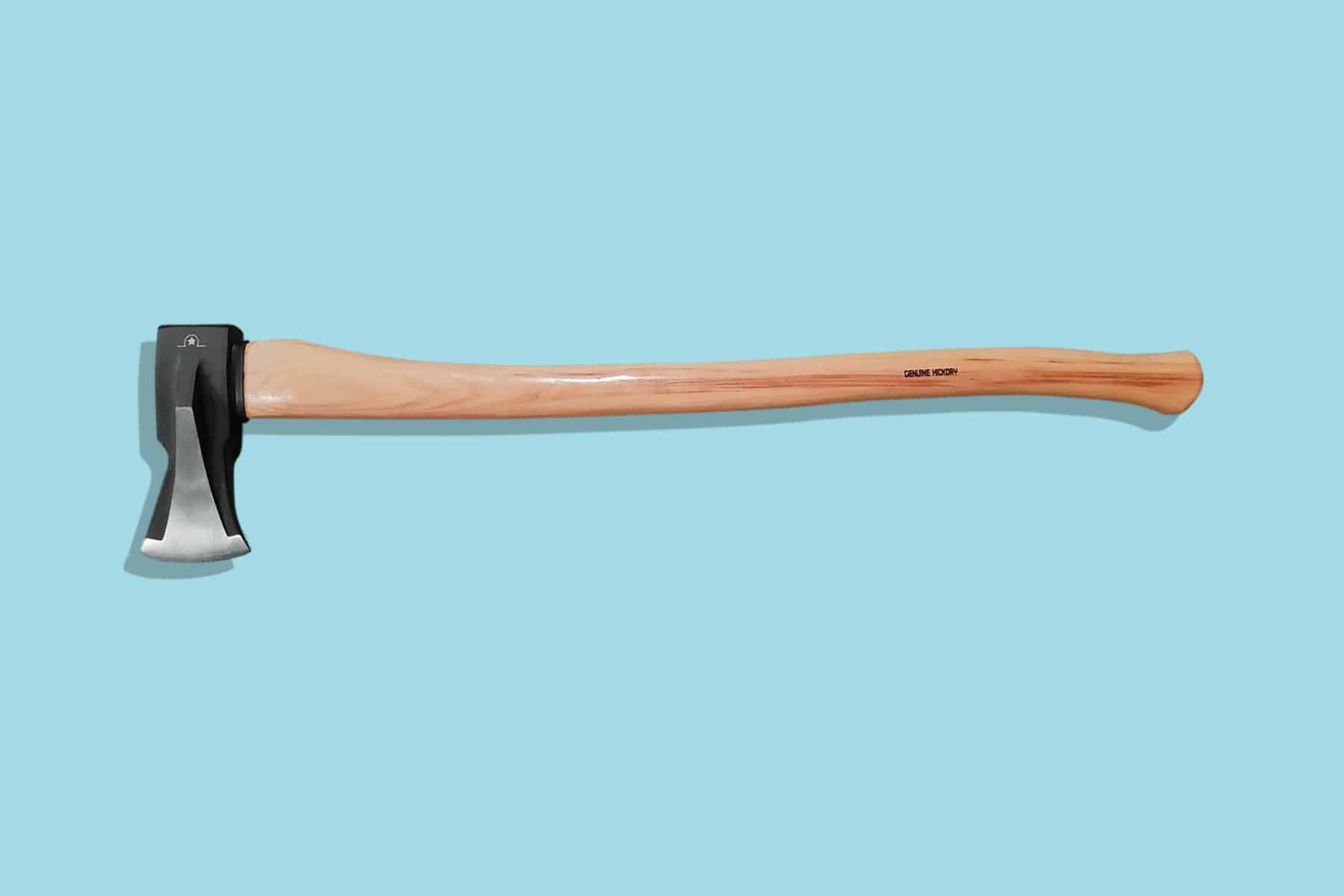OUR EDITORS INDEPENDENTLY RESEARCH, SELECT, AND RECOMMEND THE BEST PRODUCTS FOR REVIEW. AT TIMES (AND AT NO EXTRA COST TO YOU), WE MAY RECEIVE COMMISSIONS ON PURCHASES MADE THROUGH OUR CHOSEN LINKS. WE WILL ONLY EVER PROMOTE THE PRODUCTS AND SERVICES THAT WE TRUST AND 100% RECOMMEND. YOU MAY READ OUR FULL AFFILIATE DISCLOSURE POLICY FOR MORE INFORMATION.
Table of Contents
- The Best Wood Splitting Mauls in 2024
- 1. Fiskars IsoCore Splitting Maul
- 2. Fiskars Super Splitting Maul
- 3. Husqvarna Fiberglass Maul
- 4. Spear & Jackson Splitting Maul
- 5. Dewalt Exo-Core Maul
- 6. Hooyman Splitting Maul
- 7. Estwing Fireside Maul
- Tips for Choosing the Best Wood Splitting Maul
- Frequently Asked Questions (FAQs)
- Summary
Best Wood Splitting Mauls 2024 – Updated by Burbro Editors on April 14th, 2021
When you’re splitting tough wood, you’ll want an axe that carries more weight behind the axe head, like a wood splitting maul. A wood-splitting maul is a perfect tool for splitting wet wood, tough wood, tall logs and knotted wood. This is because the sheer impact of the heavier axe head is often enough to split the wood open.
If you’ve been looking for the best wood splitting maul, you’ll notice there are a lot of products on the market. However, not all wood mauls are the same, and some wood mauls aren’t built to last or worth the money. In this product review, we’ll be reviewing the best wood splitting mauls of 2024.
The Best Wood Splitting Mauls in 2024
If you’re looking for the best mauls for splitting wood, you’ve come to the right place. We’ve reviewed the top wood splitting mauls and compile the best choices into a list so you can easily find what you’re looking for.
Here are the Best Wood Splitting Mauls of 2024.
- Best Wood Splitting Maul Overall: Fiskars IsoCore Maul
- Editor’s Pick Splitting Maul: Fiskars Super Splitting Maul
- Best Lightweight Splitting Maul: Husqvarna Fiberglass Maul
- Old Fashioned Wood Maul: Spear & Jackson Splitting Maul
- Rugged Maul for Splitting Wood: Dewalt Exo-Core Maul
- Best Budget Wood Splitting Maul: Hooyman Splitting Maul
- Best Handheld Splitting Maul: Estwing Fireside Maul
1. Fiskars IsoCore Splitting Maul
Best Wood Splitting Maul Overall
2. Fiskars Super Splitting Maul
Editor’s Pick Splitting Maul
3. Husqvarna Fiberglass Maul
Best Lightweight Splitting Maul
If you’re looking for a lightweight splitting axe, you’ll want to consider the Husqvarna Fiberglass Maul. The Husqvarna Maul is 28-inches in length and about 5 pounds in weight, making it light enough to swing while carrying enough weight to split wood. The axe head is made from steel and comes pre-sharpened and ready for use. The handle is made from fiberglass material, making the handle lightweight and durable. The axe's shaft is reinforced with a stainless steel component that protects the shaft from impact if you miss the log when you’re swinging the axe. The handle also comes with a comfortable soft-grip that’s easy to hold and handle flares that prevent the axe from slipping out of your hands. The Husqvarna Fiberglass Maul also comes with a lifetime manufacturer's warranty.
4. Spear & Jackson Splitting Maul
Old Fashioned Wood Splitting Maul
If you’re an old soul, you may want to consider the Spear & Jackson Wood Splitting Maul, which is a high-quality wood maul with an old-fashioned, rustic look and feel. The S&P Splitting Maul is about 34-inches in length and 6.5 pounds in weight, making it a nice weight for splitting large logs. The axe head is made from drop forged carbon steel, tempered and hardened for better durability. The handle is made from hickory, which is known for its strength. One of the things that we noticed with the S&P Splitting Maul is that the handle can be slippery, so you may want to place a grip on the handle or use grippy work gloves, so the axe doesn’t slip out of your hand while you’re splitting wood.
5. Dewalt Exo-Core Maul
Rugged Maul for Splitting Wood
If you’re looking for an axe that’s perfect for splitting wood, you’ll want to look at the Dewalt Exo-Core Maul. The Exo-Core Maul is 36-inches in length and weighs about 4.5 pounds. The head is made from heavy-duty steel, with scallops built-in on the side of the axe head that are designed to blast the logs wide open. The handle is made from a composite fiber material, designed to withstand harsh environments while being light and durable. The handle is also hollowed, which makes the axe lighter in your backswing, and performs better when you’re splitting wood. The Dewalt Exo-Core Maul comes with a limited lifetime warranty from the manufacturer.
6. Hooyman Splitting Maul
Best Budget Wood Splitting Maul
7. Estwing Fireside Maul
Best Handheld Splitting Maul
When you’re splitting wood, you may want to consider a handheld maul like the Estwing Fireside Maul, which is perfect for splitting kindling and small logs. The Estwing Fireside Maul is 14-inches in length and about 4 pounds in weight, making it easy to control as you’re splitting wood. The Estwing Fireside Maul is forged in a single piece of steel for better durability. The handle is covered with a vinyl grip that reduces shock and makes the axe more comfortable to use. The Estwing Fireside Maul is made in the USA and comes with a manufacturer warranty.
Tips for Choosing the Best Wood Splitting Maul
If you’re new to using mauls to split wood, we’ve got you covered. In this section, we’ll provide a buyer’s guide to help you understand the features you should look for when picking a wood-splitting maul.
Here are some features to look for choosing a wood-splitting maul.
- When you’re choosing a maul axe, you’ll want to consider the size of the axe. If you choose a larger axe, you’ll find that you get more leverage when you’re trying to split large logs. However, a large maul may be more difficult for you to swing, which means that it may not be as effective as a maul that comes with a medium-sized design.
- If you’re splitting large logs, it’s best to use a larger maul because you’ll get more leverage, making it easier to split large logs. If you’re splitting small logs or medium-sized logs, you may be able to use a medium-sized wood splitting maul without encountering any problems.
- When you’re choosing a maul, you’ll need to consider the weight of the maul. A maul is different from a standard axe or a hatchet because the mauls carry more weight in the axe head, making it easier to split wood with the sheer weight and impact of the axehead.
- As you’re choosing your maul, you’ll need to decide on the weight of the axehead. Most mauls come in weights between 5-pounds to 10-pounds, so you’ll need to determine which weight is right for you. You’ll need to find the median between finding an axehead that carries enough weight to easily split wood while being light enough for you to swing with ease.
- You’ll also need to decide on the material used to create the axe head. You don’t want an axehead that cracks, breaks down or always needs to be sharpened because the edge gets damaged from splitting wood. We recommend finding a maul that comes with hardened steel so that the axehead is durable and won’t need to be sharpened as often.
- The axehead’s design will also determine how effective the axe is for splitting wood. You can find axe heads that come in a cone shape that comes to a point, or you can use an axehead that has a straight edge and has a V design. If you’re trying to split wood with your maul, we’ve found that the axeheads with the V design are the best for splitting wood. However, the cone-shaped axe heads can be used as wood-splitting wedges.
- If you go for a heavier axe head, you’ll want to ensure that the axehead comes with a blunt edge. If the edge is sharp, you’ll find that the heavy axe head will easily get stuck in the wood, and it’ll be difficult to remove. With the V Design and a blunt edge, the sheer impact and weight of the axehead will split the wood.
- Once you’ve determined the axehead’s design, weight, and material, you’ll need to look at the handle on the axe. With mauls, you’ll likely only find handles that are made from composite fiber or wood.
- If you want a lighter maul that performs better, you’ll want to choose an axe with a composite fiber handle. The composite fiber handles are lighter and usually come with anti-vibration technology which prevents impact shock, making it easier to use the maul without damaging your hands or arms.
- The wooden handles will provide a traditional feel, but they aren’t as lightweight, and they don’t perform as well. However, if you like the old soul look of a wooden axe, you’ll want to go with a splitting maul that comes with a wooden handle.
- As you’re choosing the maul’s handle, you’ll want to consider the length of the handle to ensure that it’s right for you. The handle’s length will depend on your height, the height of the logs you’re splitting and how much leverage you need to get to split the wood.
- If you’re splitting tough wood or tall logs, you’ll want a longer handle because it provides more leverage. If you’re splitting dry wood or smaller logs, then a medium-sized maul will get the job done.
- It would help if you also looked for an axe handle that comes with flares on the end of the handle. The flares will prevent the axe from slipping out of your hand while you’re swinging. This is a safety feature that can prevent injuries, especially if you’ll be splitting wood around other people.
- The handle should also come with a soft grip. A soft grip will make it easier for you to use your axe without wearing work gloves. The soft grip will also make it easier for you to grip the axe handle, and it’ll give you more control over the axehead while you’re swinging.
- When you’re choosing a wood splitting maul, you’ll need to pay attention to the price. We recommend setting a budget for your purchase to ensure that you find a product within your price range. A budget makes it easier to find the perfect product because it eliminates all the products outside of your price range, making it easier to find the best products at an affordable price.
- It would be best if you also looked for products that come with a warranty. A warranty protects you from manufacturing defects and ensures that your product is a quality item. We recommend looking for longer warranties that last longer than 2-years, so you have time to test the product before the warranty expires.
Frequently Asked Questions (FAQs)
While we were writing this article, we came across some frequently asked questions about wood-splitting mauls. In this section, we’ll address these questions and try to answer them for you.
Here are the FAQs for wood splitting mauls:
1. Is a Maul Good for Splitting Wood?
Yes. A maul is ideal for chopping large logs and tough wood. A maul is heavier, and the blunt impact of the heavier axe head is often more than enough to blast logs wide open. A wood-splitting maul is quite heavy, so they’re often reserved for the toughest wood that’s riddled with knots or wood that is wet.
2. What is the Best Tool for Splitting Wood?
When you’re splitting wood, there are several tools that you can use. You can use a wood-splitting maul for larger logs that are tough, wet or filled with knots. If the wood is dry, you may want to use a lighter axe with a thinner, sharp blade. You can use a sledgehammer and a wedge by putting the wedge into the wood and using the hammer to drive the wedge through the wood. Another option that you can use is an electric wood splitter.
3. What’s the Difference Between an Axe and a Wood Splitting Maul?
A maul is like a large sledgehammer with a pointed axe head. The maul’s blunt force is more than enough to split wood wide open. An axe is often lighter and comes with a sharp blade, and it’s easier to swing. A maul is used for chopping tall logs, tough wood, wet wood, and knotted wood. An axe is used for felling trees and splitting small logs that are almost dry.
4. Does a Maul Need to be Sharp?
No. A wood maul doesn’t need to be sharp. The blade is often rounded out from previous use, but the head’s sheer impact is enough to split the wood. While the edge doesn’t need to be sharp, it doesn’t hurt a maul to get sharpened now and then.
5. Is it Better to Split Wet or Dry Wood?
It’s always easier to split wood that has been dried out. However, it’s difficult to dry out wood that hasn’t been split because it will retain more moisture when it hasn’t been split. This is why many people use a wood-splitting maul to split wet wood and then stack the split wood off the ground, allowing the air to dry out the wood.
Summary
We hope this article has helped you find the best wood splitting maul of 2024. If you’re new to using mauls, there are some features to consider before buying a maul so that you get the right maul for your needs. First off, you’ll want to consider the side of the maul that you’re going to purchase. You won’t want a maul that’s too short or too long. If you’re shorter, you’ll want to get an axe that’s about 28-34 inches in length. However, if you’re taller, you’ll want to go for the 36-inch maul. The axe’s length will determine how easy it is to use the maul and how much leverage you can get when you’re swinging the axe.
You’ll also want to consider the weight of your maul to ensure that you get the right weight for you. If you’re splitting tough wood, wet wood, knotted wood or tall logs, you’ll want to go with a heavier axe head like a 6-pound axe head. However, if you’re chopping thin logs, you won’t need as much weight behind your maul, and you can get away with a 2-pound or 4-pound maul.
As you’re choosing the best maul, you’ll also want to ensure that the axe head is made from hardened steel, so the axe head is durable and will last the test of time. By using hardened, you won’t need to sharpen your axe as often, and the wood won’t hurt your axe head. You can also use a sledgehammer on the axe’s poll flat and drive the axe into the wood like a wedge. We also recommend that you find an axe head with a design that will blast the logs wide open because of the blade’s contour.
When you’re choosing a maul, you’ll also want to consider the handle of the axe. If you’re an old soul, you may want to use a wooden axe handle, but we recommend using composite fiber for the axe handle. This is because composite handles are lighter to use, more durable, and they perform better than wooden handles, which is essential when you’re splitting tough wood. You’ll also want an axe handle that comes with a comfortable grip, making it easy to use the wood maul and handle flares that prevent the axe from slipping out of your hands when you’re swinging the axe.



















